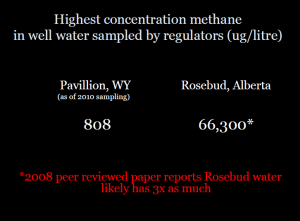Sinkhole explosive methane officially life threatening, residents not told by Deborah Dupre, October 6, 2012, examiner
Officials advised the Assumption Parish President on Thursday that Bayou Corne sinkhole area has high levels of methane in nearby water wells, posing risks to health, fire and explosion and that residents need to heed the mandatory evacuation order. That day, parish officials postponed Saturday’s resident briefing with no explanation.
“Of the chemicals reviewed, only methane, detected in the industrial water wells, presents a potential health risk (Type 2 of fire/explosion),” Dr. Raoult Ratard, State Epidemiologist of the Louisiana Department of Health and Hospitals Office (DHH) of Public Health stated in an environmental data report of the Bayou Corne oil and gas sinkhole event sent to Assumption Parish President Martin S. Triche Thursday.
…
Methane, the mysterious ‘powerful underground force’ reported by officials? Speculations are increasing that methane is the mysterious “powerful underground force”wreaking havoc in south Louisiana, including the sinkhole disaster area. Methane gas leaks are spreading throughout the south Louisiana area. Within four months, as of this week, methane bubbling sites have increased to twenty-eight, including in Pierre Part, outside the mandatory evacuation area but within hearing distance and jolts of seismic activities where foul chemical odors are nauseating and burning, as some residents there have reported. … “That whole area is hazy,” Heilig wrote. “Almost like fog, but its not foggy anywhere else.”
…
Ratard stated in the Oct. 3 letter that high levels of methane have been detected in water wells in the sinkhole area, according to DHH that reviewed 11 samples and readings. “With levels as high as 22,400, 26,600 and 27, 700 ug/L, it would appear immediate remediation is warranted,” DHH advises. … According to the parish official blog post where residents are updated, and to residents, parish officials have yet to advise them about the DHH letter about high levels of methane or what they are being encouraged to do. Gas has also been found in the aquifer above the 1-mile by 3-mile Napoleonville Salt Dome farther east and deeper underground in the dome’s hard cap rock, Department of Natural Resources (DNR) officials said. DNR then ordered the Napoleonville Dome’s seven operators to find and vent or flare any gas. On Sept. 14, the DNR issued an underreported Declaration of Emergency and Directive advisory regarding gas in the sinkhole area being life-threatening. In that advisory, Louisiana DNR’s Commissioner of Conservation James H. Welsh stated: “It is hereby declared that the presence of natural gas in formations and sands shallower than the underlying cap-rock, and in the Mississippi Alluvial Aquifer, and its top stratum in and around the Bayou Corne area has the potential to threaten lives, the environment, property and operations, sites and facilities under the regulatory authority of the commissioner of conservation.”
…
Frank’s Casing Crew and Rental Tools of Lafayette has been contracted to drill three shallow wells to explore the gas in the aquifer. … “I think they need to tell people the truth and how serious this can be,” Heilig’s mother, Deby told Dupré on the telephone Thursday. “Be honest, especially about the water; that it could be contaminated, even far from the sinkhole.” [Emphasis added]
[Refer also to:
Source: EPA data for Pavillion; Alberta regulator data for Rosebud, Alberta
Mysterious tremors 45 miles from sinkhole by Deborah Dupre, October 5, 2012, examiner
Methane bubbles have been emerging in the sinkhole vicinity for four months. There are now seventeen bubble sites percolating in the sinkhole vicinity. As far as 80 miles west, at Lake Peigneur, gas bubbling has also increased. A resident who has lived and fished in the sinkhole area for decades has reported that the entire 1-mile by 3-mile Napoleonville Salt Dome area has been sinking. Some scientists believe the sinkhole was caused when a subterranean brine cavern in the 1-mile by 3-mile Napoleonville Salt Dome collapsed. The breached cavern floor, storing radioactive materials and brine, is over 1,000 feet underground. The bottom is now leaking hydrocarbons into the cavern. Other scientists say some other powerful force has caused the cavern to breach, the seismic activity and escaping gas. [Emphasis added]

